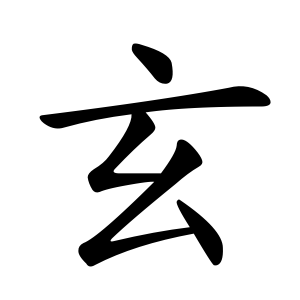玄
- deep;
- profound;
- dark;
- mysterious;
Etymology
The original meaning is “dark reddish-black,” distinct from pure black (黑). The Shuowen Jiezi explains 玄 as 黑而有赤色者爲玄—“black with some red color,” not just plain black.
Beyond color, 玄 also conveys meanings like “deep,” “profound,” “remote,” and “mysterious.” It appears in classical phrases such as 天地玄黃 (“Heaven and Earth, dark and yellow”) in the Thousand Character Classic, and in words like 玄妙 (“mysterious, subtle”). In the I Ching (Yijing), 玄天 (“dark heaven”) refers to the night sky’s darkness.
Graphically, 玄 is an ideogram originating from a shape resembling a twisted thread (like a yarn knot).
In oracle bone and bronze inscriptions, it resembled an 8; in small seal script, parts of it look like two small circles, representing twisted cords. This form led to related characters like 𢆯, from which 糸 (thread) and 玄 both derived. The connection is reflected in characters like 絃 (string), 弦 (bowstring), 鉉 (a musical instrument part), and 舷 (ship’s side), which combine the 玄 sound.
Interestingly, 玄 and 糸 are historically linked as inversions of one another in their early forms. Many characters split or differentiated over time; 玄 once shared origins with thread characters, highlighting its complex evolution.
Usage in Korean
It is used as a radical in very few characters—only about five, including 玅 (mysterious), 玆 (this), 率 (to lead), and 玈 (dark).
Notably, 玄 is omitted from the Kangxi radical list under that exact form to avoid using the character due to the personal name taboo for the Qing emperor Aisin Gioro 玄燁 (Xuanye), replaced by a simplified form 𤣥.
In summary, 玄 is a classical Chinese character symbolizing dark reddish-black, deep mystery, and profound concepts, with an origin tied to twisted threads and an important place in classical literature and philosophy.
Characters with 玄
- 卜女戈 (YVI)
- ⿱ 亠 幺
